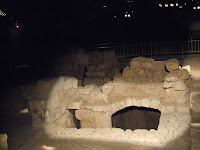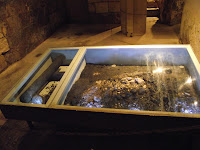Enter the glass doors at street level under Yeshivat HaKotel on Rechov HaKaraie in the Jewish Quarter of the Old City
 This was once a Jewish neighborhood that overlooked the
This was once a Jewish neighborhood that overlooked the  You can view a few enormous villas of at least three floors each with many rooms and storage rooms. You can measure the wealth of the residents by the fact that each home has a bathtub and mikveh. In those times, the observance of Taharah and Tumah laws regarding entrance into the Beis Hamikdash necessitated the use of these mikvehs. At the top of the steps leading down to the mikvehs are basins for washing one’s feet so that there would be no chaztzizah to invalidate the tvilah.
You can view a few enormous villas of at least three floors each with many rooms and storage rooms. You can measure the wealth of the residents by the fact that each home has a bathtub and mikveh. In those times, the observance of Taharah and Tumah laws regarding entrance into the Beis Hamikdash necessitated the use of these mikvehs. At the top of the steps leading down to the mikvehs are basins for washing one’s feet so that there would be no chaztzizah to invalidate the tvilah.
In every home, the floor mosaics, as well as frescoes and stuccoes, adhere to Halacha and do not show animals or people. One of the mansions features a columned courtyard where people could enjoy a clear view of the Temple Mount
 Many eating utensils and jugs were found in the area and are now in glass display cabinets. Stone utensils and tools that cannot become impure are exhibited. The affluent inhabitants imported beautiful, expensive vessels from
Many eating utensils and jugs were found in the area and are now in glass display cabinets. Stone utensils and tools that cannot become impure are exhibited. The affluent inhabitants imported beautiful, expensive vessels from  In the Pesach Haggadah we use today, we have instructions to take out the seder plate at certain points in the seder. But in the Mishna we are directed to remove the seder table itself. Viewing the little tables at the site of this museum, the Mishna becomes clear. It is apparent that each person had a little individual table from which he ate.
In the Pesach Haggadah we use today, we have instructions to take out the seder plate at certain points in the seder. But in the Mishna we are directed to remove the seder table itself. Viewing the little tables at the site of this museum, the Mishna becomes clear. It is apparent that each person had a little individual table from which he ate.  On display is an engraving of the Menorah that is believed to show an exact design of the
On display is an engraving of the Menorah that is believed to show an exact design of the  The
The  One wall of the museum displays photographs of the site during the archaeological dig in the late ‘70’s and ‘80’s.
One wall of the museum displays photographs of the site during the archaeological dig in the late ‘70’s and ‘80’s.
The Herodian Quarter is open Sunday to Thursday, from 9am to 5pm. Fridays and Erev Chag, it’s open until noon. Call 02-6265922 for more information. Admission fees are NIS 25 for adults and NIS 15 for children.
Published in 'The English Update' 24 February 2011


No comments:
Post a Comment